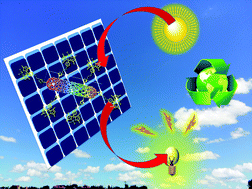Synthesis and organic solar cell performance of BODIPY and coumarin functionalized SWCNTs or graphene oxide nanomaterials†
Abstract
The synthesis and characterization of new hybrid materials based on reduced graphene oxide (rGO) or single walled carbon nanotubes (SWCNTs) covalently functionalized by 4,4′-difluoro-8-(4-propynyloxy)-phenyl-1,3,5,7-tetramethyl-4-bora-3a,4a-diaza-s-indacene (BODIPY) (2) or 7-(prop-2-yn-1-yloxy)-3-(3′,4′,5′-trimethoxyphenyl)-coumarin (4) as light harvesting groups have been described. The organic solar cell performances of these novel nanomaterials in P3HT:PCBM blends were investigated. These covalently bonded hybrid materials (reduced graphene oxide:BODIPY (GB), reduced graphene oxide:Coumarin (GC), SWCNTs:BODIPY (CB) and SWCNTs:Coumarin (CC)) were prepared by an azide–alkyne Huisgen cycloaddition (click) reaction between the azide bearing SWCNTs or rGO and terminal ethynyl functionalized BODIPY (2) or coumarin (4) derivatives. The formation of novel nanomaterials was confirmed by FT-IR, UV-Vis and Raman spectroscopies and thermogravimetric analysis. The best performance on P3HT:PCBM organic solar cells was produced by SWCNTs:Coumarin (CC) hybrids which were coated on an indium tin oxide coated polyethylene terephthalate film (ITO-PET). The reference device based on the P3HT:PCBM blend without CC showed a power conversion efficiency (PCE) of 1.16%, an FF of 35% and a short-circuit current density (Jsc) of 5.51 mA cm−2. The reference device with CC hybrids within the P3HT:PCBM blend increased the values significantly to 1.62% for PCE, 40% for FF and 6.8 mA cm−2 for Jsc.


 Please wait while we load your content...
Please wait while we load your content...